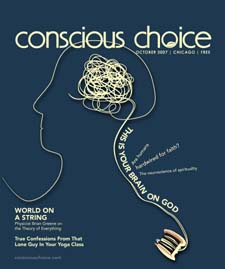 The following article below about Yoga Nidra appeared in the October, 2007 issue of Conscious Choice magazine.
The following article below about Yoga Nidra appeared in the October, 2007 issue of Conscious Choice magazine.
Awake At Last by Dana Demas
Yoga Nidra — the “new” 4000-year-old practice of yogic sleep — offers real relief to war veterans and could-be parents
Picture Iraq war veterans and hopeful mothers-to-be lying together in deep meditative silence, discovering “Pure Awareness.”
According to Richard Miller, president of Center for Timeless Being, a nonprofit educational center in Sebastopol, CA, the scene is not as far-fetched as you might imagine.
“Yoga Nidra has been under the radar for decades,” says Miller, who is also a clinical psychologist and master yoga/meditation teacher. “But [now it’s being] brought to the forefront through clinical research.”
For the past two years Miller has traveled the country teaching the ancient Tantric practice, sometimes referred to as yogic sleep. And while Yoga Nidra may be coming soon to a yoga studio near you (see sidebar), Miller is most excited about the doctors, social workers and other mainstream practitioners who are attending his intensive workshops to bring the practice to their patients.
The hot new yoga trend is actually a 4000-year-old transformative process. In Yoga Nidra classes, students systematically uncover and discard self-limiting beliefs, paving the way to feel joy again.
And like every good vehicle, it’s a hybrid. “Yoga Nidra is a systemized form of yoga and meditation with a goal of awakening you to your true nature,” explains Miller. “It’s a program of deep relaxation, self-inquiry and restoration.”
After practicing and including the technique in his yoga classes since the ’70s, Miller adapted Yoga Nidra into a program called iRest (short for Integrative Restoration). He’s finding success using iRest with soldiers suffering from post-traumatic stress disorder (PTSD). After participating in a twice-weekly practice for nine weeks, patients at Walter Reed Army Medical Center in Washington DC reported decreased insomnia, depression and anxiety and an increased sense of comfort and control in their lives. Results were so impressive that iRest is now a standard offering at the military hospital — and a large-scale, national clinical study is underway for 2008.
“Yoga Nidra helps people understand themselves as Pure Awareness, untouched by the trauma they have suffered or are suffering. They enter into a state of profound equanimity and peace that offers a vantage point they normally wouldn’t have,” says Miller.
He describes Pure Awareness as the part of the individual that exists outside of the mind-body complex — the part that never sleeps, and knows all the answers. Pure Awareness, says Miller, is an anchor to steady us through life’s storms — helping us to realize we are already exactly as we need to be.
Lie Still And Unpeel
It’s 2 o’clock on a Saturday afternoon and 31 of us are lying prone in a large classroom, preparing to practice Yoga Nidra with celebrated meditation teacher, Elesa Commerse.
We’ve gotten comfortable — on top of or under blankets, with eye masks and other savasana adjustments: bolsters under the knees and towels as pillows. But bodily comfort is not the goal of the next 40-70 minutes. In fact, the idea is to leave the body behind, so our deepest nature can be revealed.
And while Yoga Nidra is sometimes referred to as “yogic sleep,” catching up on our Zzz’s is not the order of the day. Commerse repeats her quiet mantra, “Do not sleep. Do not sleep…” as she begins to take us, layer by layer, into the deep recesses of the mind.
We travel through the five koshas, the sheathes that obscure our true nature like layers of an onion: physical body, energy body, feeling body, thinking body and the final veil of ordinary awareness. We get tricked into thinking we are this kosha or that kosha — this feeling or that thought, Commerse counsels. While our responses to these feelings and thoughts become embedded, they are not who we truly are.
As she gently guides us through body-sensing, breath and energy awareness, Commerse asks us simply to witness what we find. Each layer has something healing to reveal, she says.
And though it’s not today’s goal, we learn that with regular practice, Yoga Nidra unearths our buried feelings — our cellular memories of trauma — and consciously guides us to safe passage. When we integrate everything inside of us, the good, the bad and the painful, what we fear or are most limited by bubbles to the surface — and evaporates.
The raison d’etre of Yoga Nidra is the sankalpa: the seed of our deepest intention that we plant in the fertile soil of an emptied mind. A sankalpa, stated at the beginning and end of every practice, works on a deep, subconscious level to reshape our beliefs and our lives, says Commerse. “A sankalpa is your definition of the good life, come to life,” she explains.
Nidra Babies
Fertility patients are the next frontier for Yoga Nidra’s seed of hope. Tami Quinn, co-founder and co-director of Pulling Down the Moon fertility centers in Chicago, says that in addition to the stress-reducing benefits of Yoga Nidra, “The hope is that something profound will happen through the practice that changes a couple’s perspective. They will desire happiness and find it, with or without a child.”
Yoga Nidra calls us to witness ourselves and to accept what we find. As we peer through the layers of emotion, sensation and thought, we discover the gleaming diamond inside, our true self, which has remained untouched by the worst of what life has brought us.
Joy and happiness are — and were — always present.
Dana Demas is a freelance writer based in Chicago. She falls asleep to Richard Miller’s voice every night on CD.